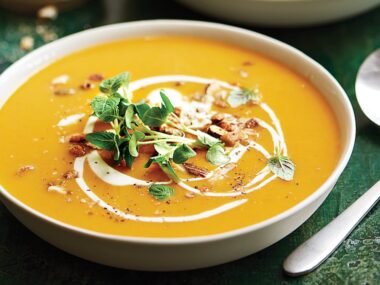Mbongo Tchobi is a traditional Cameroonian dish celebrated for its rich flavours, hearty ingredients, and aromatic spices. Originating from the diverse culinary landscape of Cameroon, Mbongo Tchobi is a spicy and aromatic stew made with slow-cooked beef or fish, enriched with palm nut butter, and seasoned with an array of spices and herbs.
This essay delves into the tantalizing world of Mbongo Tchobi, exploring its history, ingredients, preparation methods, and cultural significance in Cameroonian cuisine.
Origins and History of Mbongo Tchobi
Mbongo Tchobi traces its origins to the rich culinary traditions of Cameroon, a country renowned for its diverse array of dishes influenced by its various regions, ethnic groups, and cultural heritage. The dish is believed to have originated among the Bassa people of central Cameroon, who have long cherished Mbongo Tchobi as a beloved delicacy enjoyed at festive gatherings, celebrations, and family meals.
Ingredients of Mbongo Tchobi
- Beef or Fish: Mbongo Tchobi can be made with either beef (often with cuts like beef shank or beef stew meat) or fish (such as tilapia, catfish, or mackerel), providing a hearty and satisfying protein base for the stew.
- Palm Nut Butter: A key ingredient in Mbongo Tchobi, palm nut butter is made from the pulp of ripe palm nuts, which are boiled, pounded, and strained to extract the rich, creamy butter used to thicken and flavour the stew.
- Spices and Herbs: Mbongo Tchobi is seasoned with an array of aromatic spices and herbs, including African black pepper (also known as grains of paradise), allspice, cloves, garlic, ginger, and fresh herbs such as basil, parsley, and scallions.
- Vegetables: While not always included, Mbongo Tchobi may incorporate vegetables such as onions, tomatoes, and bell peppers, adding depth of flavour and texture to the stew.
- Hot Peppers: To impart heat and spice to the stew, Mbongo Tchobi often includes hot peppers such as Scotch bonnet peppers or habaneros, which are finely chopped or blended into the sauce.
Preparation of Mbongo Tchobi

- Preparation of Palm Nut Butter: To make palm nut butter, ripe palm nuts are boiled, pounded, and strained to extract the rich, creamy butter, which is then set aside for later use in the stew.
- Preparation of Meat or Fish: If using beef, the meat is typically cut into bite-sized pieces and seasoned with salt and pepper before being browned in a hot skillet. If using fish, it is cleaned, seasoned, and sometimes fried briefly before being added to the stew.
- Preparation of Stew Base: In a large pot or Dutch oven, onions, tomatoes, and bell peppers are sautéed in palm oil until softened and fragrant. Hot peppers, garlic, ginger, and spices are added to the pot, infusing the stew with their aromatic flavours.
- Addition of Palm Nut Butter: Once the stew base is well-cooked, palm nut butter is added to the pot, along with water or broth to create a rich and creamy sauce. The stew is simmered gently, allowing the flavours to meld and the sauce to thicken.
- Incorporation of Meat or Fish: The browned meat or fried fish is added to the pot, along with any juices accumulated during cooking, ensuring that the protein is fully cooked and infused with the flavours of the stew.
- Simmering and Seasoning: Mbongo Tchobi is simmered gently over low heat, allowing the flavours to develop and intensify. Additional seasonings, such as salt, pepper, or fresh herbs, may be added to taste, adjusting the balance of flavours as needed.
- Serving: Mbongo Tchobi is typically served hot, accompanied by a side of steamed rice, boiled plantains, or fufu, providing a hearty and satisfying meal that celebrates the vibrant flavours of Cameroonian cuisine.
Cultural Significance of Mbongo Tchobi
Mbongo Tchobi holds significant cultural importance in Cameroonian cuisine, symbolizing community, tradition, and the joys of shared meals with loved ones. It is often prepared for special occasions, festive gatherings, and family celebrations, where it serves as a centrepiece dish that brings people together in joyful camaraderie.
Mbongo Tchobi is also cherished as a comforting and nourishing meal enjoyed on everyday occasions, reflecting the rich culinary heritage and hospitality of Cameroon.
Health Benefits of Mbongo Tchobi
While Mbongo Tchobi is undeniably rich and flavorful, it also offers a range of health benefits, including:
- Protein: The beef or fish in Mbongo Tchobi provides essential amino acids necessary for muscle growth, repair, and overall health.
- Omega-3 Fatty Acids: Fish varieties such as mackerel or catfish are rich in omega-3 fatty acids, which have been linked to heart health, brain function, and reduced inflammation.
- Antioxidants: The aromatic spices and herbs in Mbongo Tchobi, such as cloves, garlic, and ginger, are rich in antioxidants that help protect against cellular damage and support overall well-being.
- Vitamins and Minerals: Mbongo Tchobi may contain a variety of vegetables and herbs, providing essential vitamins, minerals, and dietary fibre that promote overall health and vitality.
Conclusion
Mbongo Tchobi is a culinary masterpiece that embodies the rich flavours, vibrant colours, and aromatic spices of Cameroonian cuisine. Made with slow-cooked beef or fish, enriched with palm nut butter, and seasoned with a tantalizing blend of spices and herbs, Mbongo Tchobi is a feast for the senses, inviting diners on a flavorful journey into the heart of Cameroon.
Whether enjoyed at festive gatherings, family celebrations, or everyday meals, Mbongo Tchobi is a beloved delicacy that nourishes the body and soul, celebrating the rich cultural heritage and culinary traditions of Cameroon.
Related Tags
Taiwo Olawuyi
Taiwo Olawuyi is a highly dedicated and passionate professional blogger, renowned for her ability to create captivating, informative, and engaging content in the realm of health and wellness. She holds a Bachelor's degree in Political Science from Olabisi Onabanjo University and a Master's degree in Adult Education from the prestigious University of Ibadan. Her profound passion for health and wellness, coupled with her unwavering dedication to her audience, serves as a constant source of inspiration and enlightenment for readers worldwide.










